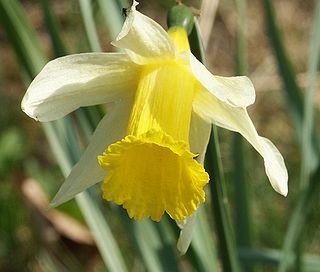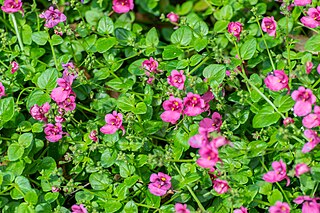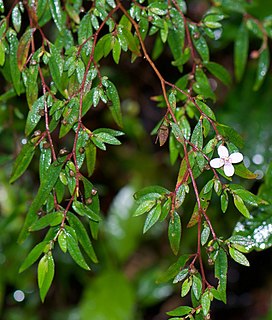
Eschscholzia californica, the California poppy, golden poppy, California sunlight or cup of gold, is a species of flowering plant in the family Papaveraceae, native to the United States and Mexico. It is cultivated as an ornamental plant flowering in summer, with showy cup-shaped flowers in brilliant shades of red, orange and yellow. It is also used as food or a garnish. It became the official state flower of California in 1903.

Pelargonium is a genus of flowering plants which includes about 280 species of perennials, succulents, and shrubs, commonly known as geraniums, pelargoniums, or storksbills. Geranium is also the botanical name and common name of a separate genus of related plants, also known as cranesbills. Both genera belong to the family Geraniaceae. Carl Linnaeus originally included all the species in one genus, Geranium, and they were later separated into two genera by Charles Louis L'Héritier de Brutelle in 1789.

Alstroemeria, commonly called the Peruvian lily or lily of the Incas, is a genus of flowering plants in the family Alstroemeriaceae. They are all native to South America although some have become naturalized in the United States, Mexico, Australia, New Zealand, Madeira and the Canary Islands. Almost all of the species are restricted to one of two distinct centers of diversity, one in central Chile, the other in eastern Brazil. Species of Alstroemeria from Chile are winter-growing plants while those of Brazil are summer-growing. All are long-lived perennials except A. graminea, a diminutive annual from the Atacama Desert of Chile.

Osteospermum, is a genus of flowering plants belonging to the Calenduleae, one of the smaller tribes of the sunflower/daisy family Asteraceae. They are known as the daisybushes or African daisies.

Rosa gallica, the Gallic rose, French rose, or rose of Provins, is a species of flowering plant in the rose family, native to southern and central Europe eastwards to Turkey and the Caucasus. It was one of the first species of rose to be cultivated in central Europe.

Kerria japonica, commonly known as Japanese rose or Japanese kerria, is a deciduous shrub in the rose family Rosaceae, native to China, Japan and Korea. It is named after William Kerr, who introduced the cultivar 'Pleniflora'. It is the sole species in the genus Kerria.

Narcissus pseudonarcissus is a perennial flowering plant.

Cornus alba, the red-barked, white or Siberian dogwood, is a species of flowering plant in the family Cornaceae, native to Siberia, northern China and Korea. It is a large deciduous surculose (suckering) shrub that can be grown as a small tree. As a popular ornamental used in landscaping its notable features include the red stems in fall (autumn) through late winter, the brightest winter bark of any cornus; and the variegated foliage in some cultivars, such as C. alba 'Elegantissima', in which the discreet flat whitish flower clusters are almost lost in the variegated texture and dappled light. C. alba can grow to 3 m (10 ft) high, but variegated forms are less vigorous. For the brightest winter bark, young shoots are encouraged by cutting to the ground some older stems at the end of the winter, before leaves are open. The oval fruits are white, sometimes tinted blue.

Chaenomeles speciosa, the flowering quince, Chinese quince, or Japanese quince, is a thorny deciduous or semi-evergreen shrub native to eastern Asia. It is taller than another commonly cultivated species, C. japonica, usually growing to about 2 m. The flowers are usually red, but may be white or pink. The fruit is a fragrant but hard pome that resembles a quince.

Aloidendron barberae, formerly Aloe bainesii and Aloe barberae, also known as the tree aloe, is a species of succulent plant in the genus Aloidendron. It is native to South Africa northwards to Mozambique. In its native climes this slow-growing tree can reach up to 60 feet (18 m) high and 36 inches (0.91 m) in stem diameter. Aloidendron barberae is Africa's largest aloe-like plant. The tree aloe is often used as an ornamental plant. Its tubular flowers are rose pink (green-tipped); it flowers in winter and in its natural environment is pollinated by sunbirds.

Salvia greggii, the autumn sage, is a herbaceous perennial plant native to a long, narrow area from southwest Texas, through the Chihuahuan Desert and into the Mexican state of San Luis Potosi, typically growing in rocky soils at elevations from 5,000 to 9,000 ft. It was named and described in 1870 by botanist Asa Gray after Josiah Gregg, a merchant, explorer, naturalist, and author from the American Southwest and Northern Mexico, who found and collected the plant in Texas. It is closely related to, and frequently hybridizes with, Salvia microphylla. Contrary to its common name, it blooms throughout the summer and autumn.

Erysimum cheiri, syn. Cheiranthus cheiri, the wallflower, is a species of flowering plant in the family Brassicaceae (Cruciferae), native to Greece, but widespread as an introduced species elsewhere. It is also treated as a hybrid under the name Erysimum × cheiri. It is widely cultivated as a garden plant.

Diascia is a genus of around 70 species of herbaceous annual and perennial flowering plants of the family Scrophulariaceae, native to southern Africa, including South Africa, Lesotho and neighbouring areas.

Rosa'Buff Beauty' is an apricot Hybrid musk rose cultivar, bred by Ann Bentall and introduced into Great Britain in 1939. Bentall and her husband, John Bentall, inherited the rose fields of acclaimed rose breeder, the Reverend Joseph Pemberton after his death in 1926. The rose was awarded the Royal Horticultural Society's Award of Garden Merit in 1993.

Eriocapitella × hybrida is a hybrid of flowering plants in the buttercup family Ranunculaceae. The parents of the hybrid are E. japonica and E. vitifolia. Cultivars of the hybrid are commonly known as Japanese anemone hybrids.

Diascia rigescens, called the stiff twinspur, is a species of flowering plant in the genus Diascia, native to South Africa. It has gained the Royal Horticultural Society's Award of Garden Merit.

Diascia vigilis, called the twinspur or elf spur, is a species of flowering plant in the genus Diascia, native to South Africa. It has gained the Royal Horticultural Society's Award of Garden Merit.

Plectranthus ciliatus, called Indian borage, speckled spur flower, blue spur flower, and candlestick plant, is a species of flowering plant in the family Lamiaceae. It is native to South Africa and Swaziland, and introduced to Victoria in Australia and the North and South Islands of New Zealand. With its Coleus‑like foliage, its cultivar 'Easy Gold' has gained the Royal Horticultural Society's Award of Garden Merit as an ornamental.

Centradenia inaequilateralis is a species of flowering plant in the family Melastomataceae, native to southern Mexico, and Central America. With its pink-purple flowers, its cultivar 'Cascade' has gained the Royal Horticultural Society's Award of Garden Merit.




















